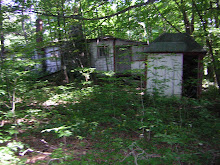The folkloric record of Western Civilization is full of stories of animals popping up where they ought not to be.
The literature on unexplained phenomenon is replete not only with controversial creatures, such as Bigfoot, Nessie and El Chupacabras, but with animals whose existence no one disputes, but who seem to be flouting all zoological convention in their choice of habitat. Hundreds of reports of such appearances have been recorded: alligators turning up randomly in major cities, kangaroos hopping about the Midwest, panthers skulking about the Australian bush or the English countryside - these are but a few examples. These kinds of stories greatly appeal to me, perhaps because they depict a kind of renegade spirit in the animal kingdom, a certain pluckiness in nature that defies our attempts to neatly order and catalogue it.
I discovered a story of this sort in the November 8, 1908 edition of the Berkshire Evening Eagle. Anthony and Louis Spiewak, two brothers who lived on Broadview Terrace in Pittsfield, had been hunting for grouse in Lanesboro four days earlier when they had a most uncommon encounter. They heard a rustling in some nearby trees and went to check it out. They were shocked to find out that the source of the rustling had not been birds, as they expected, but instead two monkeys scampering about. It's not every day that monkeys can be seen roaming wild in the Berkshires, and the Spiewak brothers were understandably perplexed. Where could they have come from?
An explanation, of sorts, was not long in coming. Oliver Pillizzaro, proprietor of Red's Dairy Bar on Cheshire Road, said that he believed that the pair had to have been ones who escaped from his care back in June. For several years, a group of monkeys he owned had served as an attraction to draw customers to his business. In June, three of them had broken loose and taken off into the woods. One of them returned on its own soon after, but after a three-day search no sign of the other two could be found, and they were given up for lost.
Now, as any school child knows, monkeys thrive in locales throughout the southern hemisphere, and are hardly accustomed to the kind of weather conditions that autumn in the Berkshires entails. Nonetheless, the Spiewaks told reporters that the fugitive simians seemed utterly unperturbed, and even appeared quite healthy and happy in their surroundings. As for Pillizzaro, he was surprised to hear that they were alive at all, given the freezing temperatures that they had been faced with that fall.
The befuddled owner said that he intended to organize a search party to scour the area where they had been seen, in the hopes of recovering his pets. I have not been able to find out whether or not any such mission was undertaken successfully, or if the monkeys were ever spotted again by anyone else in the region.
Personally, I like to imagine that the pair never was apprehended. Perhaps, I muse, they somehow found it possible to adapt to the chilly Northeastern winter, as some of their distant primate cousins did in the past, and lived out the remainder of their natural lives in this new environment, snacking on a range of exotic herbivorous cuisine as they frolicked merrily through the forest. Perhaps they mated the following spring, and a few of their descendants still reside in isolate pockets of forest, a safe distance from their noisy cousins. On the other hand, maybe they migrated that very winter, striking out for warmer regions, as certain other area residents have been known to do. I realize, of course, that these are all pretty whimsical speculations on my part, and not terribly plausible.
Then again, they're not that much less plausible than the story was to begin with - or than most of what I read in the papers any other day, for that matter. These hills are alive with the song of unlikely scenarios, and there certainly seems to be far more to primate behavior than is dreamt of in my philosophy.
Thursday, September 15, 2005
Subscribe to:
Comments (Atom)


